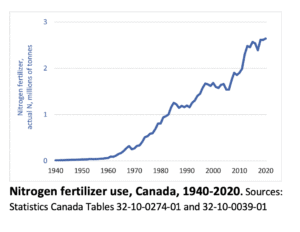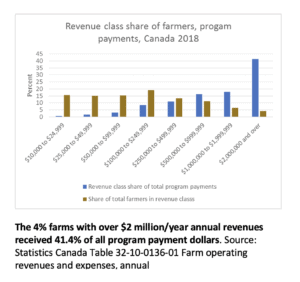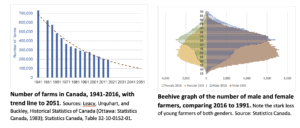The National Farmers Union sent the following letter to each federal and provincial Agriculture Minister in the lead-up to their annual conference, which will be held virtually in July. At this meeting they will develop the set of priorities, principles and measuring sticks that will guide the successor to the Canadian Agricultural Partnership programs, called the Next Agricultural Policy Framework. Later in the process detailed programs, including Business Risk Management programs, will be developed.
Dear Minister
RE: Priorities for the Next Agricultural Policy Framework
As you prepare for the upcoming conference of Federal, Provincial and Territorial Agriculture Ministers, the National Farmers Union would like to offer input for your discussion of priorities for the Next Agricultural Policy Framework.
The National Farmers Union (NFU) is a voluntary direct-membership, non-partisan, national farm organization made up of thousands of farm families from across Canada who produce a wide variety of food products, including grains, livestock, fruits and vegetables. Founded in 1969, the NFU advocates for policies that promote the dignity, prosperity and sustainable future of farmers, farm families and their communities. Our governance structure has included women and youth leadership for our entire history. The NFU is a leader in articulating the interests of Canada’s family farms, in analyzing the farm income crisis, and in proposing affordable, balanced, and innovative solutions that benefit all citizens. NFU policy positions are developed through a democratic process of discussion and debate by members at regional and national conventions.
We promote food sovereignty, which is a holistic approach that puts people, food and nature in the centre of the policy picture, and that makes democratic control of the food system its priority. Food sovereignty is about empowering farmers and eaters to define their own systems to produce healthy and culturally appropriate food for people through ecologically sound and sustainable methods that support community prosperity. It values food providers, builds knowledge and skills and works with nature. Numerous surveys and opinion polls indicate that non-farming Canadians generally share these values and support efforts to ensure farmers obtain fair returns from producing wholesome food and other agricultural products in an environmentally friendly way.
An opportunity for fairness and wisdom
The Next Policy Framework (NPF) is a key policy tool to shape the future of agriculture in Canada. This $3 billion investment over the five-year program period, combined with improvements to Business Risk Management program design, is significant, allowing governments, on behalf of their citizens and residents, to shape our food and farming system to produce results that serve the needs and interests of the Canadian public. Each five-year policy framework reflects a vision informed by recent events and long-term trends. In the next period, from 2023 to 2028, Canada will face multiple crises that affect agriculture, and where good agriculture programs are needed to make a positive difference. Canadians are counting on you to use the tools available through the NPF to wisely and fairly address the food system weaknesses made visible by the pandemic, reverse biodiversity loss in our agricultural landscapes, drastically reduce the greenhouse gas emissions from agriculture and help farmers adapt to the climate crisis, rebuild rural prosperity by addressing massive and growing inequality in the allocation of farm revenues and net income, and address the alarming loss of farmers by making farming both possible and attractive for the next generation.
In Victoria, you will weigh the merits of different priorities, and consider which will provide the best outcomes for our food system, our farmers and the Canadian public. You will decide on indicators and set targets for success, as well as guiding principles for implementation. We encourage you and your fellow ministers to use the lenses of the common good, sustainability, and resilience when assessing each element of the Next Policy Framework.
Inclusive goals, strategies and targets
In its annual report, Agriculture and Agri-Food Canada includes goals, indicators and targets for increasing agricultural exports and for the Canadian agriculture and agri-food sector’s contribution to growth of Canada’s Gross Domestic Product. There are no indicators for agri-food imports, the impacts of its policy on farmers, farmland or climate, nor the availability to consumers of food produced on Canadian farms. The lack of attention to AAFC policy impacts on farmers, farm communities and Canadian consumers may be due to its over-reliance on the Agriculture Economic Strategy Table established by former Finance Minister Morneau, and comprised almost entirely of the CEOs of large corporations involved in exporting. We hope that by consulting with a broader range of stakeholders, you and your fellow Agriculture Ministers will bring forward a more inclusive set of goals and strategies and targets for the Next Policy Framework.
Our priorities for the Next Policy Framework
The following is our concise list of priorities for the NPF, with an example or explanation under each category. These ideas are just a small sample of the many proactive policy and program ideas. We welcome further conversations with you and your staff to further elaborate on ways to implement these priorities.
Increase infrastructure capacity for local, regional and domestic agricultural production, processing, storage, transportation and distribution to unleash the potential of Canada’s family farmers to serve the domestic Canadian market and retain a higher proportion of the consumer dollar within our national, regional and local economies.
- An example is the crisis in provincially-licensed abattoirs. At a time when consumers increasingly seek to support local producers, and livestock producers are adopting climate-friendly grazing systems, access to abattoirs has declined in many areas. This infrastructure bottleneck is one of many hindering growth of vibrant regional food systems across Canada.
Promote farmer-led innovation and knowledge-sharing to increase farmer autonomy, provide mentorship and inter-generational knowledge transfer.
- Farmers are problem-solvers. As new challenges arise, they meet them with creativity, whether through adapting machinery, inventing new processes or applying knowledge learned over a lifetime. Innovation does not have to mean new products and inputs, it can mean supporting an “internet of farmers” to share knowledge, skills and techniques.
Uphold our supply management system for dairy, chicken, turkey and eggs, and support in ways that increase its farmer numbers and provide alternative production and processing opportunities.
- Safeguarding our supply management from further erosion in trade negotiations will save Canada from paying billions in subsidies as dairy-exporting countries do. The NPF can also help marketing boards become more inclusive of alternative production systems, on-farm processing and increase the number of new entrants able to participate in these sectors.
Help farmers mitigate and adapt to climate change risks by setting targets for GHG emission reduction, funding extensive new agri-environmental programs, and establishing a Canadian Farm Resilience Administration to support transition to low-emission production.
- Help farmers understand their emissions and make reductions plans by equipping them with tools such as nutrient management plans, soil health plans, and support their action by implementing Environmental Farm Plan 3.0 along with a wide range of incentives to adopt enhanced rotations including cross-fencing and boundary fencing, cover crops, lower-input approaches, manure management best practices, equipment electrification and renewable energy generation.


Build public trust in government by ensuring NPF investment results in more farmers, increases young farmers’ access to land by reversing the trend to ever larger farms, and provides valued service to farmers including publicly funded agronomists and free soil testing.
- Young people who aspire to farm could obtain secure access to land without incurring a crippling debt burden by participating in alternative land tenure systems such as co-operatives, land trusts or non-family members succession frameworks supported by development funding through the NPF.
Build public trust in the food system by regulating for, and promoting the kinds of ecologically friendly farm practices that a growing proportion of consumers demand.
- Greater on-farm biodiversity, cover-cropping, integrated pest management, permaculture design, are examples of farm practices that increase resilience, reduce input costs and deliver ecological services. Supporting farmers to transition to these methods will improve the public perception of agriculture policy.
Ensure Business Risk Programs are accessible, relevant and useful for farms of different sizes and production systems, with capped payouts to avoid incentivizing excessive expansion and risk-taking by the largest farms.
- Program evaluation data demonstrates that the current design of BRM programs are inequitable, with the bulk of payouts going to a small minority of farms. Taxpayer supported safety net programs should not worsen inequity and instability within the sector.

Reverse decline in farm numbers by supporting intergenerational farm transfer, new and young farmers and access for marginalized groups.
- Canada’s loss of farmers is alarming, particularly in mid-sized farms and middle-aged farmers. Strategic policy action is needed to ensure we have a next generation of farmers. There are thousands of aspiring young farmers who can succeed with better access to land, equipment, education and training that does not result in crippling debt and unmanageable able risk.

Make funding available only to small and medium enterprises, farm organizations, academic, and public interest groups to promote public support for continued taxpayer contributions to agriculture.
- Large agribusiness corporations and their lobby groups do not need government funding.
Policies to Avoid
In addition to recommending the above policies, we are aware that there has been some discussion of the following policy ideas, which we urge Ministers to avoid or reverse:
Private Insurance
The current CAP program includes AgriRisk funding to research private insurance mechanisms, with a view to potentially replacing some of the current BRM risk management tools. We do not support this direction, and would urge it to be dropped from further consideration.
Farmers operate with razor thin margins and are subject to many risks that are outside of our control – from climate change, to currency fluctuations, political crises in export markets, and pandemics – and farmers are price-takers when buying inputs and selling products. Even with the most prudent management, these combined risks can be devastating. Private insurance, particularly farmer-funded insurance, would not protect farmers in the long-run, as the money to pay for insured losses would have to come from premiums paid by farmers. Private insurance is designed to be profitable for the insurance-provider, thus as risks mount and payouts become more expensive, premiums rise and coverage is reduced. Private insurance would become unaffordable for increasing numbers of farmers, and especially those with less financial capacity. Private insurance would accelerate the exit of today’s farmers and create barriers for new entrants. In contrast, a publicly funded business risk management system is also an accountability measure that rewards policy makers for shaping an economic environment where farmers can succeed.
Private Certification
We also urge you not to consider NPF funding for private certification schemes that make environmental and/or health claims, for example. These are often promoted by multinational corporations, ostensibly to differentiate products based on certain qualities. Because these schemes are not transparent, third-party verified or government-regulated, their claims may not be true or meaningful, yet farmers may be denied access to markets or have their price discounted if they do not participate. Certification may require invasive data sharing, and enable commodity traders to manipulate prices to their advantage. The best way to ensure continuing access to sensitive markets and consumer support is through a robust regulatory system based on the precautionary principle to safeguard the air, water, biodiversity, and the lands we farm.
Measuring success
AAFC uses export growth as its primary indicator of success, and exports have risen (as have imports)

Yet at the same time, net farm income has gone down, and debt continues to rise. This is evidence that increasing exports does not necessarily translate into the well-being of Canadian farm families.

We therefore recommend you use the following indicators to measure success of the NPF. For those indicators where data sets are not available, AAFC, Statistics Canada or other appropriate government agencies should be mandated to create protocols and establish baseline data by 2023.
- Total number of farmers (up)
- Average age of farmers (down)
- Number of producers who are women, Indigenous, Black and People of Colour (up)
- Farm debt (down)
- Realized net farm income (up)
- GHG emissions from fertilizer production, use and application (down)
- Soil Organic Carbon (up)
- Area of wetlands, grasslands, shelter belts and other wildlife habitat in agricultural landscapes (up)
- Percentage of beef, pork and poultry killed at provincially licensed facilities (up)
- Farmgate price of commodities (up)
- Imports of high value food (excluding items that require tropical or subtropical climate) (down)
- Sales of domestically produced food (up)
We look forward to a positive direction for Canada’s farm families as a result of your upcoming deliberations. The NFU welcomes dialogue and will be pleased to provide additional detail about all of the priorities presented in this letter.
Sincerely,
Katie Ward, President
National Farmers Union
